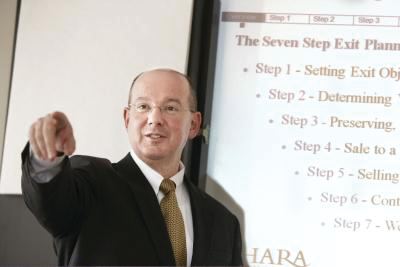CPA firms, as well as their small business clients headed by those of the “baby boomer” generation, may feel the urgency for an in-house succession plan to be certain their firm or business is headed in the right direction-to build business value and secure a future for themselves as well as their key employees.
CPAs need to prepare their own exit plan with the understanding of where their clients are in their own exit plans. A CPA practice value is based on a strong client base with the opportunity to generate fees in the future. With so many closely held business owners being the same age as their CPAs, both are looking to exit their business/practice in the same time frame.
The statistics are clear; 65% of single owner and 63% of multi owner CPA Firms are currently tackling succession planning while at the same time, 78 million baby boomers are planning their retirement. The challenge is who will be superseding these CPA’s and Business Owners today and in the coming years.
There is a shortfall in recruitment, as the next generation of Business Owners-the Gen-Xers are at a staggering low of 49 million, clearly not being able to replace the baby boomer workforce. Competition for the Xers talent is staging up to be very intense due to the significantly lower numbers of available Key Employees in this generation.
Now is the time for the Baby Boomers to take a look at this next generation, as the Gen-Xers are waiting in the wings, ready and able to assume leadership positions and operate businesses. It is imperative today to ensure the time to identify your key employees-those with all the right stuff-and start a conversation about what their future within the company holds.
Without this conversation, your valued key employee(s) may depart to secure a successful future with your competitor. Communication can make the difference between staying for the long haul or leaving for another opportunity.
IT IS CRITICAL TO CREATE A KEY EMPLOYEE INCENTIVE PLAN
Key Employee Incentive Planning is not just about financial techniques, but more importantly the process the Business Owner goes through to create & then manage the Plan. Therefore, it’s in a business owners’ best interest to identify one to three people who have successor potential and create long-term incentive plans for them – complete compensation packages that include not only financial incentives, but also individualized benefits to secure solid business value.
While the general imperative is to establish an environment in which these key staff members can substantially share in the company’s value and profits, particularly over the long term, be aware that compensation means different things to different people. Certainly, regular salary increases is one way to motivate and retain staff, but most high level employees would likely agree that work satisfaction is defined by more than a hefty paycheck.
Chosen potential successors have already demonstrated their engagement and commitment to the organization – otherwise they wouldn’t be on the short list to eventually take over. But they will become even more invested within their roles if the business owner(s) clearly communicate how they, as key employees, will be rewarded by sharing in the value they help create.
One of the many factors in creating, motivating, and keeping good management is a properly designed incentive plan. To be successful, an incentive plan must motivate the management team to increase the value of the company in a measurable way.
Long-term incentive plans should consist of a number of components so that executives have a diversified package – the more attractive this package is, the more difficult it will be for key employees to entertain a leave of the company.
Successful plans share four basic elements. First, the plan is specific. The key employees know, in advance and in writing, what standards need to be met to receive the incentive.
Second, the incentive is substantial. The key employees must perceive it as a substantial incentive worth achieving. This substantial amount is only awarded upon the attainment of the performance standards set by the business owner.
Third, the plan should tie the key management team to the business so that, regardless of who owns the company, these individuals have an incentive to remain with the business. Payments of these incentive plan awards to the key employees are not immediate. There should always be some type of vesting schedule associated with any incentive plan award. Normally, a continual or “rolling” vesting schedule is used – this approach requires each year’s award to vest on a separate schedule. Using this type of schedule will tie the key employees to the business longer as they are never fully vested in the most recent awards.
Fourth, the key employees should receive the incentive award based on performance standards that, when attained, increase the value of the business. This element is critical to a properly designed incentive plan.
Also, it cannot be overstated that employers should consult with a CPA to strengthen legal and tax advice when establishing any incentive program.
By working on their clients exit plans as part of an advisor team, the CPA can participate in the transfer planning work, earn additional fees and have the opportunity to build a relationship with the future owners of their clients’ businesses.
And, if it is time for the CPA Owner to move forward with his own succession plan, remember to create a work environment that encourages longevity and recognize that most employees are motivated by an atmosphere that acknowledges skill, allows for active participation in decision-making, provides opportunities for professional growth, and supports financial comfort now and in retirement.
Remember, each key employee is unique.
————————————-
Bob O’Hara, CPA/PFS MST, CExP™ is the founder of O’Hara & Company, a leading financial firm that specializes in guiding businesses through their exit planning process while building sustainable business value, as well as the creator of a national educational website for business owners, www.exitplanning-edu.com
Thanks for reading CPA Practice Advisor!
Subscribe Already registered? Log In
Need more information? Read the FAQs
Tags: Firm Management




